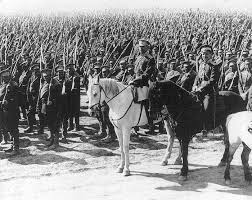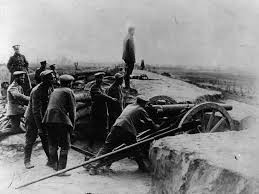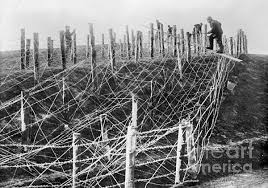War On a Titanic Scale; The Impact of Mud.
Special to The Great War Project
(24-25 September) The Russians acquire intelligence that the German army is moving toward Warsaw in Poland to take the pressure off the Austro-Hungarian forces on the Eastern Front.
The Russians make the necessary adjustments. They move armies toward Warsaw from elsewhere in Poland and from faraway Siberia, and according to war historian John Keegan, they intend to sit there and wait.
Keegan calls the Russian maneuvers “war on a titanic scale, as large in numbers committed as in the west and larger by far in terms of space and depth of movement than in any of the operations in that comparatively constricted theater.”
The Germans are not aware of the Russian troop movements.
At the same time, Germany’s unsteady ally, Austria-Hungary, is in “dreadful condition,” according to historian Norman Stone. Austria’s job is to hold off the Russians “so that Germany could win in the west.
That strategy does not work. Austria-Hungary loses half a million men, reports Stone, “100,000 of them captured.” Another garrison of 120,000 Austrian soldiers is “shut in” at the great fortress at Przemysl (pronounced PSHEH-mih-shuhl), the Austrian troops confined to the fortress by thick mud that surrounds it.
The mud keeps the Austrians in and the Russians out.
On the Western Front, the bloodletting on the Aisne continues unabated as the trench lines deepen and harden.
“This trench- and siege warfare is horrible,” writes one surprised senior German officer, quoted by historian Max Hastings. And this from a British officer: “One day very much like another. There is nearly always shelling.”
Hastings observes: “The British Expeditionary Force could take pride in the stubbornness with which it held its ground on the Aisne through a month of savage fighting, which gravely depleted many units.
“But if the allies had not lost the battle, nor had they won it.”
Nor are they – on all sides — able to absorb quickly the lessons of this new type of warfare. Historian Adam Hochschild writes: “In their introduction to trench warfare, the British made all kinds of mistakes. They did not have enough spades and sometimes had to dig with pitchforks” taken from local farmers.
The Germans prove even more maladroit, writes Hochschild. “Masses of them advanced head-on in British rifle and machine-gun fire.”
German troops advance arm-in-arm, wearing steel helmets with little spikes on top which “only made them better targets.”
“There should have been a clear lesson here,” writes Hochschild, “about how strongly this strange new style of battle favored defenders, but it was a lesson that, in different ways, each side resisted learning.”
“A single gun emplacement could stave off hundreds, even thousands of attackers.”
As for defenses writes Hochschild, “German barbed wire in particular would prove a nearly insuperable obstacle.”
Line by line, trench after trench, the battlefield becomes more and more impenetrable and impossible to maneuver.




so wrenching to follow this gathering agony daily … what a powerful job you’re doing. Thank you.